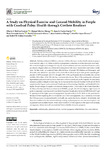Mostrar o rexistro simple do ítem
A study on physical exercise and general mobility in people with cerebral palsy: health through costless routines
| dc.contributor.author | Molina-Cantero, Alberto J. | |
| dc.contributor.author | Merino-Monge, Manuel | |
| dc.contributor.author | Castro-García, Juan A. | |
| dc.contributor.author | Pousada, Thais | |
| dc.contributor.author | Valenzuela-Muñoz, David | |
| dc.contributor.author | Gutiérrez-Párraga, Juan | |
| dc.contributor.author | López-Álvarez, Setefilla | |
| dc.contributor.author | Gómez-González, Isabel M. | |
| dc.date.accessioned | 2021-09-28T08:29:07Z | |
| dc.date.available | 2021-09-28T08:29:07Z | |
| dc.date.issued | 2021-08-31 | |
| dc.identifier.citation | Molina-Cantero AJ, Merino-Monge M, Castro-García JA, Pousada-García T, Valenzuela-Muñoz D, Gutiérrez-Párraga J, López-Álvarez S, Gómez-González IM. A study on physical exercise and general mobility in people with cerebral palsy: health through costless routines. Int J Environ Res Public Health. 2021 Aug 31;18(17):9179. | es_ES |
| dc.identifier.issn | 1661-7827 | |
| dc.identifier.uri | http://hdl.handle.net/2183/28523 | |
| dc.description.abstract | [Abstract] Sedentary behavior (SB) is a common problem that may produce health issues in people with cerebral palsy (CP). When added to a progressive reduction in motor functions over time, SB can lead to higher percentages of body fat, muscle stiffness and associated health issues in this population. Regular physical activity (RPA) may prevent the loss of motor skills and reduce health risks. In this work, we analyzed data collected from 40 people (20 children and teenagers, and 20 adults) who attend two specialist centers in Seville to obtain an up-to-date picture regarding the practice of RPA in people with CP. Roughly 60% of the participants showed mostly mid/severe mobility difficulties, while 38% also had communicative issues. Most of the participants performed light-intensity physical activity (PA) at least once or twice a week and, in the majority of cases, had a neutral or positive attitude to exercising. In the Asociación Sevillana de Parálisis Cerebral (ASPACE) sample test, the higher the International Classification of Functioning, Disability and Health (ICF), the higher the percentage of negative responses to doing exercise. Conversely, in the Centro Específico de Educación Especial Mercedes Sanromá (CEEEMS), people likes PA but slightly higher ratios of positive responses were found at Gross Motor Function Classification System (GMFCS) levels V and II, agreeing with the higher personal engagement of people at those levels. We have also performed a literature review regarding RPA in CP and the use of low-cost equipment. As a conclusion, we found that RPA produces enormous benefits for health and motor functions, whatever its intensity and duration. Costless activities such as walking, running or playing sports; exercises requiring low-cost equipment such as elastic bands, certain smartwatches or video-games; or therapies with animals, among many others, have all demonstrated their suitability for such a purpose. | es_ES |
| dc.description.sponsorship | This research was funded by the Spanish Ministry of Science and Innovation, State Plan 2017–2020: Challenges—R&D&I Projects with grant codes PID2019-104323RB-C32 and PID2019-104323RB-C33. | es_ES |
| dc.language.iso | eng | es_ES |
| dc.publisher | MDPI | es_ES |
| dc.relation | info:eu-repo/grantAgreement/AEI/Plan Estatal de Investigación Científica y Técnica y de Innovación 2017-2020/PID2019-104323RB-C32/ES/INTERACCION AFECTIVA AUMENTADA | |
| dc.relation | info:eu-repo/grantAgreement/AEI/Plan Estatal de Investigación Científica y Técnica y de Innovación 2017-2020/PID2019-104323RB-C33/ES/EVALUACION Y ASESORAMIENTO PARA LA MEJOR EFICIENCIA Y EFECTIVIDAD DE LA TECNOLOGIA DE APOYO | |
| dc.relation.uri | https://doi.org/10.3390/ijerph18179179 | es_ES |
| dc.rights | Creative Commons Attribution 4.0 International License (CC-BY 4.0) | es_ES |
| dc.rights.uri | http://creativecommons.org/licenses/by/4.0/ | * |
| dc.subject | Cerebral palsy | es_ES |
| dc.subject | Exercise programs | es_ES |
| dc.subject | Low-cost solutions | es_ES |
| dc.subject | Physical activity | es_ES |
| dc.subject | Rehabilitation | es_ES |
| dc.title | A study on physical exercise and general mobility in people with cerebral palsy: health through costless routines | es_ES |
| dc.type | info:eu-repo/semantics/article | es_ES |
| dc.rights.access | info:eu-repo/semantics/openAccess | es_ES |
| UDC.journalTitle | International Journal of Environmental Research and Public Health | es_ES |
| UDC.volume | 18 | es_ES |
| UDC.issue | 17 | es_ES |
| UDC.startPage | 9179 | es_ES |
| dc.identifier.doi | 10.3390/ijerph18179179 |






